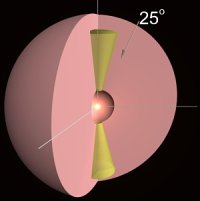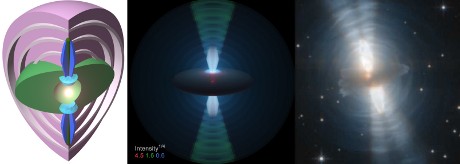
Sketch of an emerging jet ramming through the dusty shell around an AGB star.
Images below are views along 25o inclination angle.
Toward the end of their life, stars leave the main-sequence and enter the asymptotic giant branch (AGB). During this phase, strong stellar winds blow away the outer atmospheric layers, making a strong impact on the galactic environment. Large quantities of dust are formed out of this wind, engulfing the star into a spherical dusty envelope.
When the AGB phase ends, however, these spherical structures turn into mostly asymmetric planetary nebulae. The physical process responsible for this symmetry breaking remains unknown. It has been just recently that a handful of clearly asymmetric AGB objects have been detected. Such objects are quite elusive because they require a high-resolution imaging and last for only about 1,000 years or less in the end of AGB phase.
2D radiative transfer is required for the study of these asymmetric dusty envelopes. Modeling with LELUYA has already yielded some results suggesting the shaping of AGB wind asymmetries by bipolar jets.
We explored the immediate environment of the AGB star IRC+10011 and
discovered a very young jet emerging from the star, still hidden by
a dense dusty shell around the star.

Egg nebula (pre-planetary nebula):
the far left is a sketch of the circumstellar dusty environment, the middle pannels shows results of a detailed computationally extensive radiative transfer modelling (colour rendition with a non-linear contrast, blue=0.6microns, green= 1.1microns, red=1.6microns, the emerging light from the nebular core at 4.5microns is overplotted in red), and the far right is a composite multi-wavelength image from the Hubble space telescope.
Balick B., Huarte-Espinosa M, Frank A, Gomez T, Alcolea J., Corradi R.L.M, Vinkovic D.
'' Outflows from Evolved Stars: The Rapidly Changing Fingers of CRL618''
2013, ApJ, 772 (PDF)
Balick B., Gomez T, Vinkovic D., Alcolea J., Corradi R.L.M, Frank A.
''The Illumination and Growth of CRL 2688: An Analysis of New & Archival HST Observations''
2012, ApJ, 745,188 (PDF)
Vinkovic, D., Bloecker, T., Hofmann, K.-H., Elitzur, M., & Weigelt, G. 2004, MNRAS, 352, 852
ADS, PDF
|